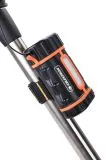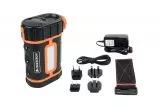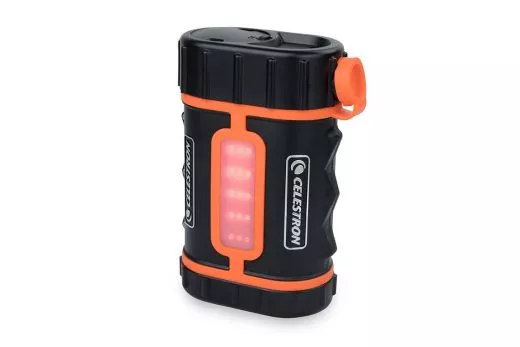- Details
- More images
- Customer-tip
Products description
Celestron PowerTank Pro Lithium LiFePo4 12V DC USB 5V 158.74 Wh 10A battery
Celestron's extra-large-capacity portable power pack with LiFePO4 battery technologyPowers your telescope for up to 17 hours
Features two USB ports for charging other devices, plus a 12V car battery adapter port
LED panel for up to 25 hours of bright white or red LED illumination
Perfect for astronomy, camping, emergency kits, and anywhere you need portable power
Meets current FAA carry-on regulations
PowerTank Pro LiFePO4 12V DC / USB 5V / 158.74 Wh
Compatible with the following devices:
Advanced VX CPC, CPC DX
AstroFi NexStar Evolution
CG-5 NexStar GT
CGE Pro NexStar SE Series
CGEM II NexStar SLT
CGEM, CGEM DX SkyProdigy
LCM Series CGX
The PowerTank Lithium Pro is designed for true professional use Power users! This even higher-capacity battery pack is the latest version of our best-selling PowerTank Lithium. It offers twice the battery capacity of the original, making it ideal for more demanding applications.
The PowerTank Lithium Pro features ports for a wide variety of devices. There's a 12V DC 5A telescope power port (Celestron cable included), a 12V DC 10A car battery adapter port, and two 5V DC USB ports – one with 2.1A and one for fast charging.
Thanks to its extremely portable form factor, you can take the battery pack anywhere, from remote dark-sky locations for astrophotography to a weekend camping trip. You can use the included 2" straps to attach the device to your telescope's tripod leg where it won't get in the way.
An LED panel for white and red light is located on one side of the PowerTank. This makes the PowerTank a convenient safety light for nighttime observing or a work light when packing up at night. You can even use it as a bright emergency light in the event of a power outage, illuminating an entire room in your home.
The PowerTank Lithium Pro can also accompany you on your next vacation. With 158.74 Wh, it complies with current FAA regulations (160 Wh) for carry-on luggage. Please check with your airline in advance to see if they have stricter guidelines.
Advantages of the Celestron LiFePO4 Battery
The PowerTank is powered by Celestron's lithium iron phosphate (LiFePO4) battery and is smaller, lighter, and safer than traditional lead-acid batteries. The technology is also more environmentally friendly because it doesn't use toxic heavy metals.
The LiFePO4 battery lasts up to 2,000 charge cycles and has an uncharged shelf life of up to 10 years. This means you don't have to remember to recharge your PowerTank every few months. Its large 17 amp-hour capacity and maintenance-free design make the PowerTank Lithium Pro the ideal choice for emergency power. Keep one in your home, garage, or even your office.
For mounts with increased power requirements, two power tanks can be combined with the Baader Planetarium Dual-Mode Cable Set (#2457635) to provide 24V power – for example, for professional mounts like the 10Micron GM 1000. The cable is custom-made and currently only available directly from Baader Planetarium.
Tripping Hazard Power Cable
We recommend using a Protective-Disconnect Angled Connector (#2457634) from Baader Planetarium, and not just for mobile mounts. If excessive tension is applied, the connector detaches from the cable, reducing the risk of damage to your mount. Without this important safety feature, a lightweight mount could fall over or the connector could be ripped out of the mount if someone trips over the cable, for example. The Protective-Disconnect Angled Connector provides a predetermined breaking point in the event of excessive stress and also holds better in the mount than many inexpensive cables. This allows for the desire to screw the cable to the mount for better support without the need for a screw connection.
Comparison of the PowerTank Lithium Pro and PowerTank Lithium
PowerTank Lithium Pro VS. PowerTank Lithium Celestron PowerTank LiFePO4 12V DC/USB 5V/84.4Wh
158.74 WH Battery Capacity 86.4 WH
2 kg (4.5 lbs) Weight 1 kg (2.25 lbs)
5 Charging Ports 3
12VDC @5000mA, positive terminal inside Telescope Power Port 12VDC @3000mA, positive terminal inside
12VDC @10A, positive terminal inside 12V CAR Battery Port Adapter N/A
MANUFACTURER Celestron
ITEM NUMBER (#) 821042
EAN CODE 4047825040008
WEIGHT (KG) 2 (4.5 lbs)
ADAPTABLE TO All computer-controlled Celestron mounts and mounts with identical specifications
INPUT (V) 16VDC @ 2000mA
OUTPUT (V) Telescope: 12VDC @ 5000mA, positive pole inside; Cigarette lighter: 12VDC @ 10A, positive pole inside; USB 1: 5VDC @ 2100mA; USB 2: 5VDC Quick Charge
OUTPUT PORT Telescope, 2x USB, Cigarette lighter
SPECIAL FEATURES 2m connection cable for Celestron telescopes (5.5mm, positive pole inside)
ACCESSORIES INCLUDED: Charger with various plugs, connection cable for Celestron telescopes, Velcro strap for attaching to the tripod, instructions
GUIDE TO POWERING YOUR TELESCOPE: CELESTRON POWERTANK AND POWERTANK LITHIUM
This post was published on October 5, 2018 by Team Baader Planetarium.
Last edited on October 15, 2018.
Owners of computer-controlled telescopes today have a variety of options for powering their telescopes, even in remote observing locations. Lance Lucero is our Astronomy Product Manager and responsible for the development of our PowerTank Lithium and PowerTank Lithium Pro batteries. In this interview, he provides an overview of the various options.
What options do I have for powering a Celestron telescope?
Of course, you can power your telescope with a 12V power supply. Some telescopes come with one included, while others allow you to connect a separate power supply. This is the most convenient and inexpensive power supply for permanently installed telescopes or if an electrical outlet is available at your observing location. However, when setting up your telescope, be careful not to accidentally trip over the cable in the dark.
[Note: Many inexpensive power supplies don't provide enough voltage in cold temperatures. We therefore recommend the Baader Outdoor Telescope power supplies, which are also designed for use in low temperatures.
Many of our telescopes run on standard batteries, either in a separate battery pouch or in a built-in battery compartment. This works, but if you observe regularly, you'll need to buy new batteries regularly. Unfortunately, rechargeable AA batteries don't provide enough voltage to reliably power a telescope (1.2 volts instead of 1.5 volts). This is where special battery packs for astronomy come into play. Celestron has four portable models with different capacities and prices in its range: the old PowerTank and PowerTank 17 as well as the new Celestron PowerTank LiFePO4 12V DC/ USB 5V/ 84.4Wh (#821041, ¤ 164,-) and now also the PowerTank Pro LiFePo4 12V DC / USB 5V / 158.74 Wh (#821042, ¤ 299,-).
What are the advantages and disadvantages of lead-acid batteries like the original PowerTank and PowerTank 17?
PowerTank and PowerTank 17, Lead-acid Batteries: Most people are familiar with lead-acid batteries from their everyday lives, as this battery technology is also used in car batteries. This technology works well there, too, as the battery is constantly charged while driving. However, it suffers when left unused for extended periods. (This is why you need to charge your car battery after you haven't driven for a few weeks.) If you use a lead-acid battery for astronomy, you'll need to charge and discharge it fairly regularly. It should go through a full discharge/charge cycle about once a month to maintain its performance. Lead-acid batteries are no longer state-of-the-art, but they are still popular and work reliably if well maintained.
However, lead-acid batteries, like car batteries, don't last forever. You can extend its lifespan with proper care, but you'll likely need to replace it after about two years.
So, lead-acid batteries aren't a perfect solution (nor the most environmentally friendly), but they've been in use for decades. If you're willing to invest time in battery care, they're a cost-effective way to store power. The original PowerTank was a lower-capacity battery, best suited for telescopes like the NexStar SLT and below. The larger PowerTank 17 was designed for larger telescopes and longer nights of observing.
What are the advantages and disadvantages of lithium iron phosphate (LiFePO4) batteries?
Whether it's the Transportation Security Administration (TSA) banning certain smartphones on board airplanes or the major "hoverboard" fiasco of 2015, it seems that unsafe lithium batteries are always in the news. After deciding to develop our own lithium battery, safety was naturally one of our main concerns.
We quickly learned that not all lithium batteries are created equal. Therefore, we decided to spend a little more money on lithium iron phosphate (LiFePO4) technology rather than using the cheaper but less reliable lithium cobalt oxide. LiFePO4 is not only safer but also more powerful. This allows it to deliver a constant 12V voltage, unlike its competitors, instead of degrading during use. Furthermore, LiFePO4 batteries have about four times more charge cycles than their lithium cobalt oxide competitors.
The only downside to our PowerTank Lithium and PowerTank Lithium Pro is the higher purchase price. But it's worth it: With 2,000 charge cycles per battery, LiFePO4 is cheaper over the years than a lithium-cobalt battery with only 500 cycles, or even a lead-acid battery with even fewer cycles. Furthermore, a LiFePO4 battery requires no regular maintenance once fully charged. This makes it ready for use even after a long period of use, whether for your telescope or as a backup power supply during a power outage!
Other manufacturers sell "lithium batteries" for astronomy. What's the difference between Celestron's PowerTank Lithium and PowerTank Lithium Pro?
Since the first computerized telescopes, amateur astronomers have been devising their own power solutions. In the 1980s, the first tinkerers converted old-fashioned car batteries to power their telescopes, and the rest is history. Many other power sources on the market weren't designed for astronomy either. The small 155-watt-hour lithium batteries that have appeared online are actually reusable power packs for portable CPAP respirators.
CPAP machines have significantly different power requirements than telescope mounts. Telescopes are more demanding and must be constantly powered at or near 12V to function optimally. On a telescope, these batteries never deliver a full 12V and quickly lose power, draining to 11V in less than two hours.
Then there are the different form factors. To power a telescope with a CPAP battery, you'll likely need to use a small adapter cable that adapts the 12-volt output to a cigarette lighter plug, and then connect a cigarette lighter adapter to that adapter. The power cable for many telescopes is less than a meter long, so it won't reach the power input of most equatorial mounts if the power source is on the ground.
Our team at Celestron developed the Celestron PowerTank LiFePO4 12V DC/USB 5V/84.4Wh (#821041, ¤164) and the PowerTank Pro LiFePO4 12V DC/USB 5V/158.74Wh (#821042, ¤299) specifically for astronomy. The high-quality battery maintains a constant voltage until the last 30 minutes of its charge, and the form factor is perfect for telescopes, including Velcro straps for attaching to tripod legs. Strapping the battery to a tripod leg allows the cables to remain short and out of the way, eliminating tripping hazards and tangled cables.
Why doesn't the PowerTank Lithium Pro include an AC outlet?
We actually considered incorporating a standard AC outlet into the PowerTank Lithium Pro, as other battery packs on the market also offer this feature. However, after testing these devices, we realized it doesn't make sense for a battery of this size to have an AC circuit.
Voltage converters are notoriously inefficient. In addition, these 155 Wh batteries require an internal fan to keep the batteries cool when they're feeding the AC port. The fan's power consumes power, which then drains your device. All of these factors combine to make the AC outlet much less useful than you might think.
To demonstrate this, we connected a competitor's 155 Wh battery to a single 60-watt light bulb via the AC port. It ran out of power after two hours.
Of course, a light bulb is the last thing you want to power while observing or astrophotography. So we tested it with a laptop. The battery's specifications indicated a maximum power of 100 watts. Most laptop chargers require between 70 and 125 watts. But running autoguiding software and image capture software simultaneously requires more power. Not surprisingly, the laptop required more than 100 watts, and the battery shut down after two minutes to prevent damage.
So instead of adding an essentially useless AC outlet to the PowerTank Lithium Pro, we opted for a built-in "cigarette lighter" port, which is compatible with many telescopes and astronomical accessories.
Customers who bought this product also bought the following products:
Shipping time:  In stock + testing
In stock + testing
 In stock + testing
In stock + testingOur previous price 89,00 EUR Now only 84,00 EURyou save 6% / 5,00 EUR
19 % VAT incl. excl. Shipping costs
Shipping time:  In stock + testing
In stock + testing
 In stock + testing
In stock + testing99,00 EUR
VAT excl. excl. Shipping costs
Shipping time:  In stock + testing
In stock + testing
 In stock + testing
In stock + testingOur previous price 519,00 EUR Now only 469,00 EURyou save 10% / 50,00 EUR
19 % VAT incl. excl. Shipping costs
Shipping time:  Product requires explanation
Product requires explanation
 Product requires explanation
Product requires explanationOur previous price 299,00 EUR Now only 289,00 EURyou save 3% / 10,00 EUR
19 % VAT incl. excl. Shipping costs
Shipping time:  In stock + testing
In stock + testing
 In stock + testing
In stock + testing33,00 EUR
19 % VAT incl. excl. Shipping costs
Shipping time:  In stock + testing
In stock + testing
 In stock + testing
In stock + testingOur previous price 77,00 EUR Now only 75,00 EURyou save 3% / 2,00 EUR
19 % VAT incl. excl. Shipping costs
This Product was added to our catalogue on 06/11/2018.
Categories
Quick purchase
Welcome back!
Last viewed:
Manufacturer
Shipping country














